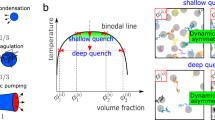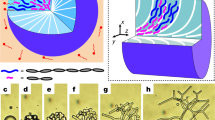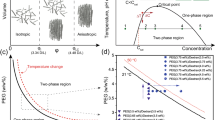Abstract
Phase separation is one of the most fundamental physical phenomena that controls the morphology of heterogeneous structures. Phase separation of a binary mixture of simple liquids produces only two morphologies: a bicontinuous or a droplet structure in the case of a symmetric or an asymmetric composition, respectively. For complex fluids, there is a possibility to produce other interesting morphologies. We found that a network structure of the minority phase can also be induced transiently on phase separation if the dynamics of the minority phase are much slower than those of the majority phase. Here we induce a cellular structure of the minority phase intentionally with the help of its smectic ordering, using phase separation of a lyotropic liquid crystal into the isotropic and smectic phase. We can control the three morphologies, cellular, network and droplet structures, solely by changing the heating rate. We demonstrate that the kinetic interplay between phase separation and smectic ordering is a key to the morphological selection. This may provide a new route to the formation of network and cellular morphologies in soft materials.
This is a preview of subscription content, access via your institution
Access options
Subscribe to this journal
Receive 12 print issues and online access
$259.00 per year
only $21.58 per issue
Buy this article
- Purchase on Springer Link
- Instant access to full article PDF
Prices may be subject to local taxes which are calculated during checkout






Similar content being viewed by others
References
Weaire, D. & Hutzler, S. The Physics of Foams (Oxford Univ. Press, Oxford, 1999).
Matsuyama, H., Berghmans, S. & Lloyd, D. R. Formation of hydrophilic microporous membranes via thermally induced phase separation. J. Membr. Sci. 142, 213–224 (1998).
Kleman, M. & Lavrentovich, O. D. Soft Matter Physics: An Introduction (Springer, New York, 2003).
Tanaka, H., Hayashi, T. & Nishi, T. Application of digital image analysis to pattern formation in polymer systems. J. Appl. Phys. 59, 3627–3643 (1986).
Tanaka, H. Pattern formation caused by double quenches in binary polymer mixtures—Response of phase-separated structure to a 2nd quench within a 2-phase region. Phys. Rev. E 47, 2946–2949 (1993).
Milner, S. T., Cates, M. E. & Roux, D. Hydrodynamic modes and topology in microemulsions and L3 phases. J. Physique 51, 2629–2639 (1990).
Porte, G. et al. Scaling laws for some physical properties of the L3 (sponge) phase. J. Physique II 1, 1101–1120 (1991).
Tanaka, H. Appearance of a moving droplet phase and unusual network-like or sponge-like patterns in a phase-separating polymer solution with a double-well-shaped phase diagram. Macromolecules 25, 6377–6380 (1992).
Tanaka, H. Universality of viscoelastic phase separation in dynamically asymmetric fluid mixtures. Phys. Rev. Lett. 76, 787–790 (1996).
Hohenberg, P. C. & Halperin, B. I. Theory of dynamic critical phenomena. Rev. Mod. Phys. 49, 435–479 (1977).
Anderson, V. J., Terentjev, E. M., Meeker, S. P., Crain, J. & Poon, W. C. K. Cellular solid behaviour of liquid crystal colloids 1. Phase separation and morphology. Eur. Phys. J. E 4, 11–20 (2001).
Glazier, J. A., Gross, S. P. & Stavans, J. Dynamics of two-dimensional soap froths. Phys. Rev. A 36, 306–312 (1987).
Durian, D. J., Weitz, D. A. & Pine, D. J. Scaling behavior in shaving cream. Phys. Rev. A 44, R7902–R7905 (1991).
Burnett, G. D., Chae, J. J., Tam, W. Y., Dealmeida, R. M. C. & Tabor, M. Structure and dynamics of breaking foams. Phys. Rev. E 51, 5788–5796 (1995).
Chae, J. J. & Tabor, M. Dynamics of foams with and without wall rupture. Phys. Rev. E 55, 598–610 (1997).
Meeker, S. P., Poon, W. C. K., Crain, J. & Terentjev, E. M. Colloid-liquid-crystal composites: An unusual soft solid. Phys. Rev. E 61, R6083–R6086 (2000).
Helfrich, W. Steric interaction of fluid membranes in multilayer systems. Z. Naturforsch. a 33, 305–315 (1978).
Le, T. D., Olsson, U., Mortensen, K., Zipfel, J. & Richtering, W. Nonionic amphiphilic bilayer structures under shear. Langmuir 17, 999–1008 (2001).
Acknowledgements
The authors are grateful to U. Olsson for providing the information on the phase diagram of a C10E3/water mixture, to C. P. Royall for critical reading of the manuscript and valuable comments, and to M. E. Cates for valuable suggestions on the mechanism of foam formation. This work is partly supported by a grand-in-aid from the Ministry of Education, Culture, Sports, Science and Technology, Japan.
Author information
Authors and Affiliations
Corresponding author
Ethics declarations
Competing interests
The authors declare no competing financial interests.
Rights and permissions
About this article
Cite this article
Iwashita, Y., Tanaka, H. Self-organization in phase separation of a lyotropic liquid crystal into cellular, network and droplet morphologies. Nature Mater 5, 147–152 (2006). https://doi.org/10.1038/nmat1580
Received:
Accepted:
Published:
Issue Date:
DOI: https://doi.org/10.1038/nmat1580
This article is cited by
-
Viscoelastic phase separation in biological cells
Communications Physics (2022)
-
Power-law coarsening in network-forming phase separation governed by mechanical relaxation
Nature Communications (2021)
-
Numerical prediction of colloidal phase separation by direct computation of Navier–Stokes equation
npj Computational Materials (2019)



